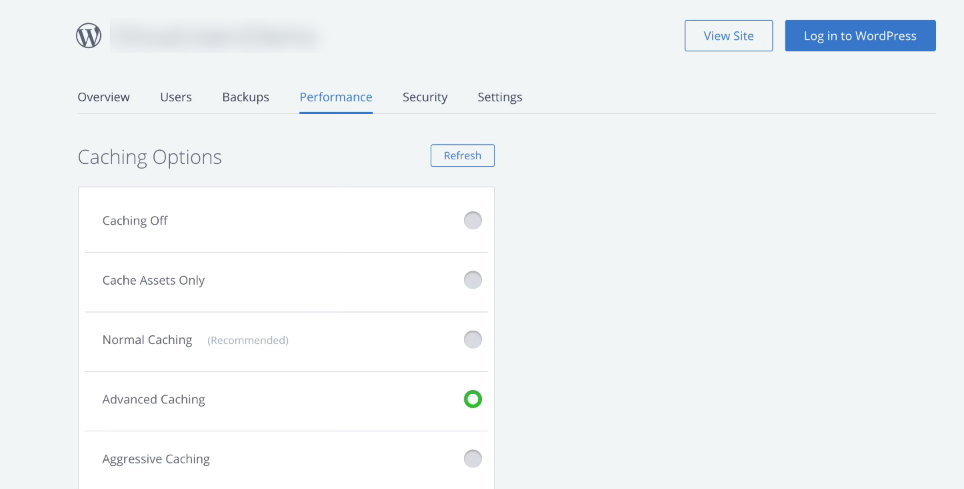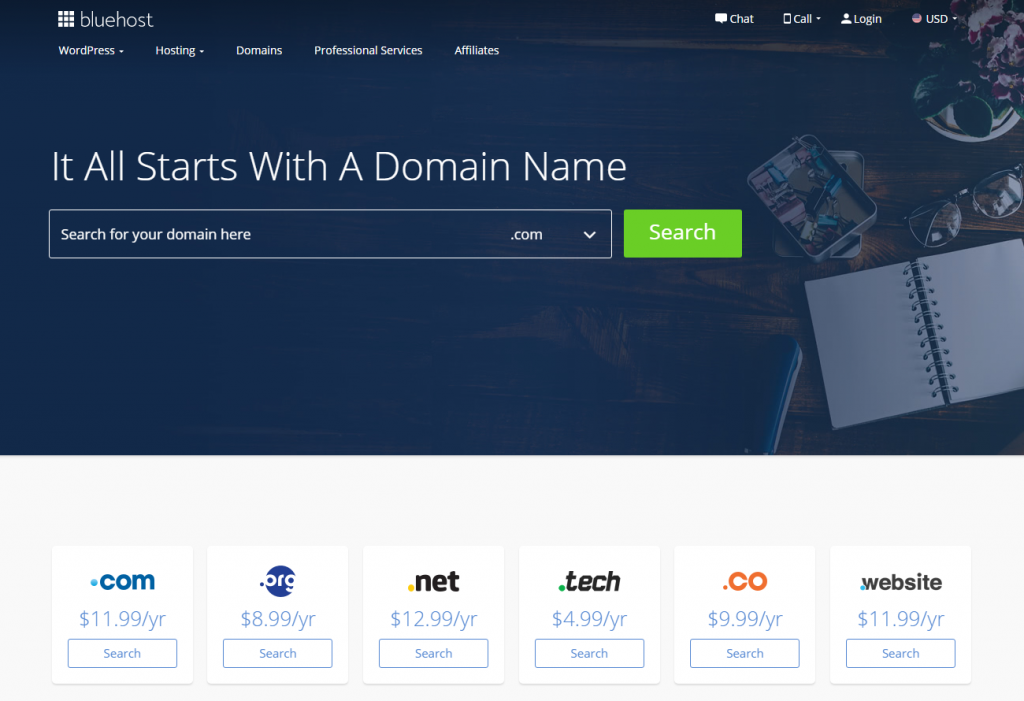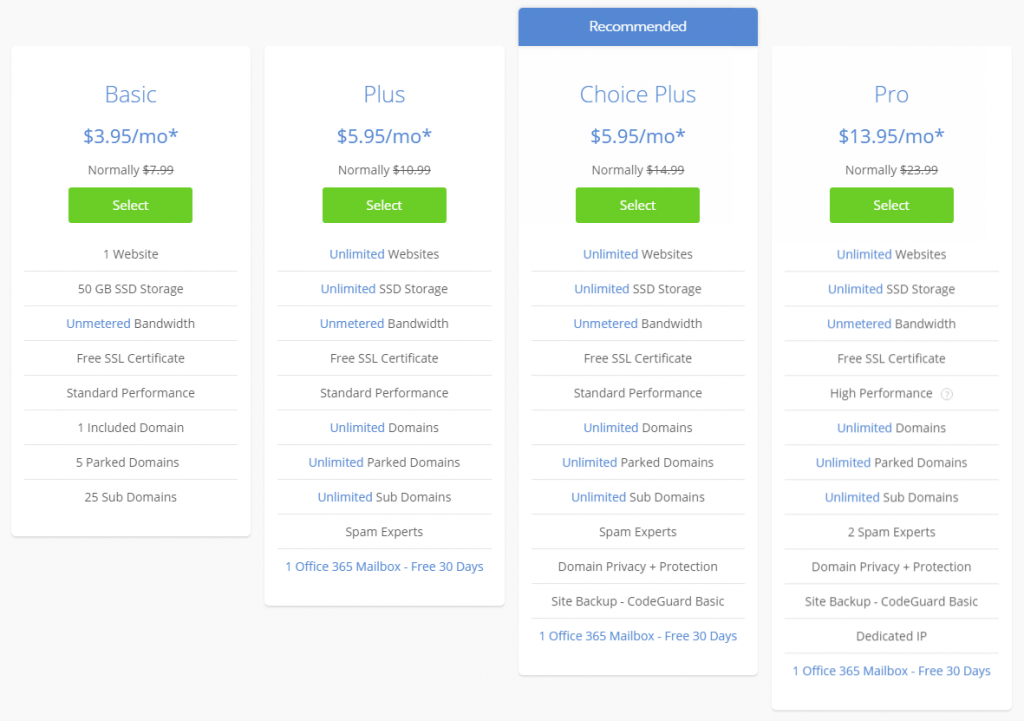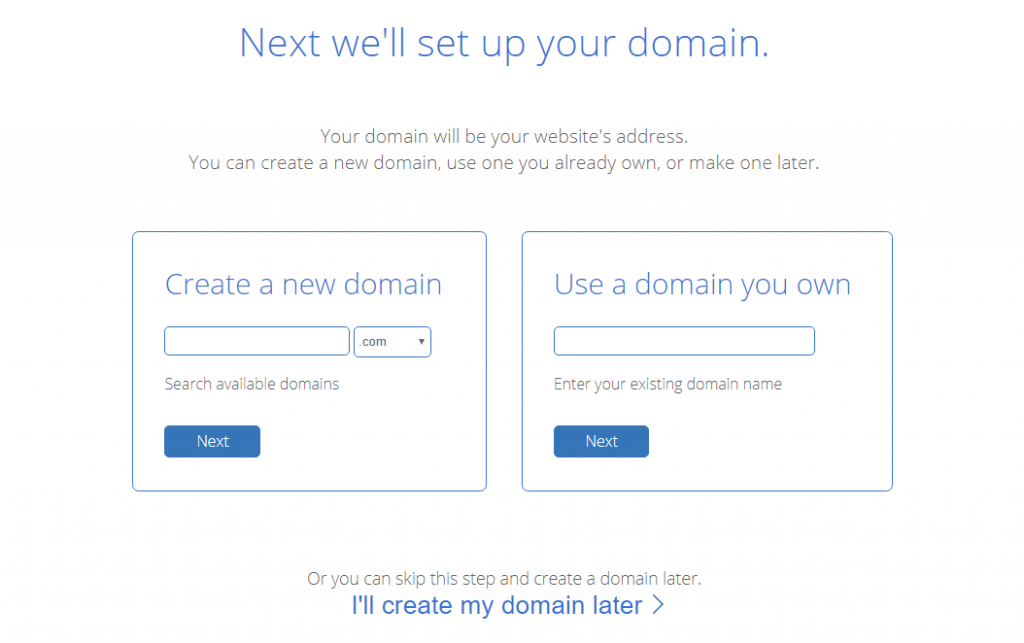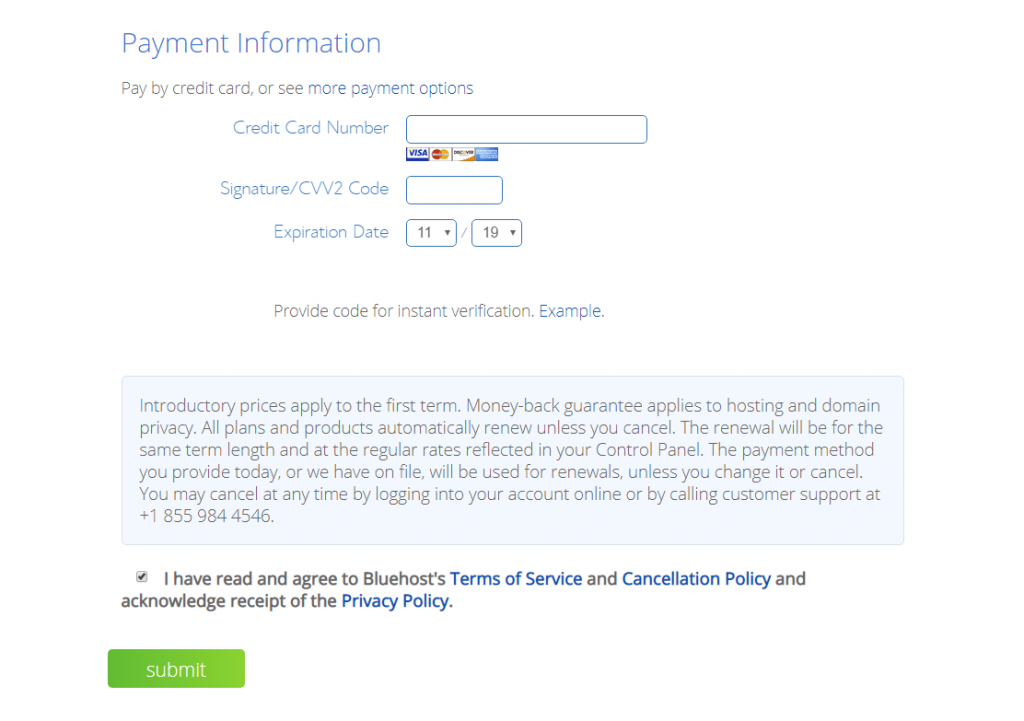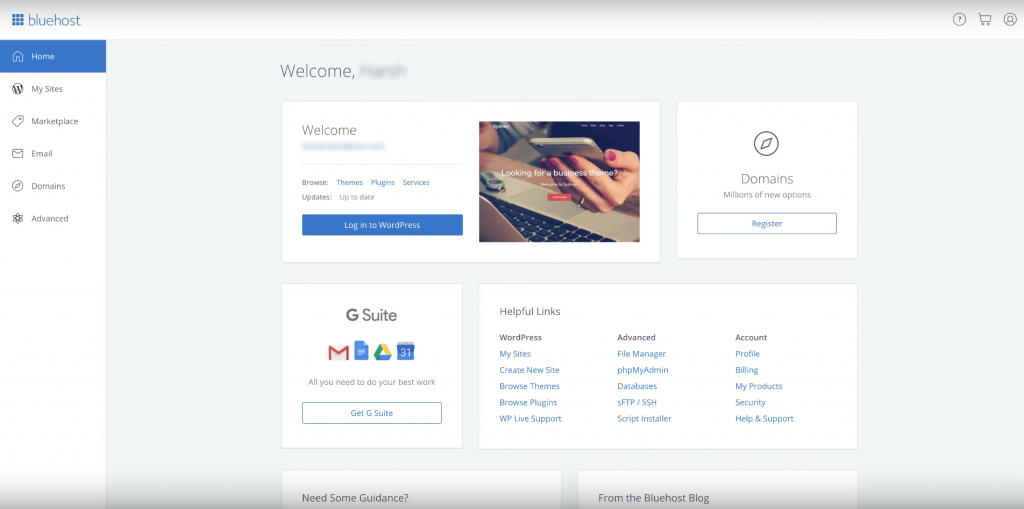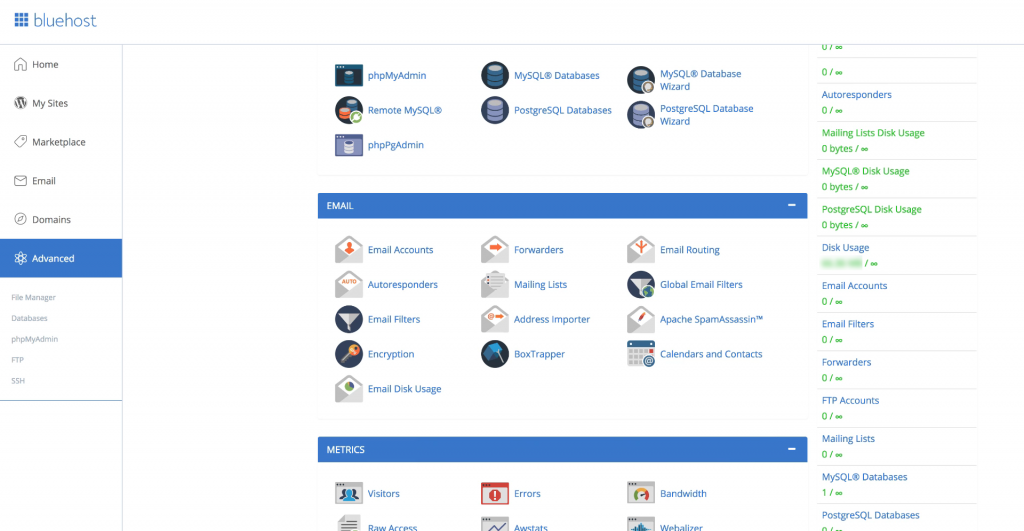This post contains Bluehost affiliate links. You can read our affiliate disclosure here.
Web hosting is required when you want to create any sort of website. Without it, you have nowhere to store the contents of that site.
There are over 1.5 billion websites on the Internet today, and hundreds of thousands of new ones are being created each day.
No matter what kind of business you are – manufacturer, dentist, plumber, internet marketer, or entrepreneur – it’s extremely beneficial to have a web presence.
Simply put, if you don’t have a website, you’re leaving big money and brand awareness on the table.
Of course, when you build a website, you want to choose a high-quality web host that is reliable and fast. There are certainly a lot of candidates out there competing for your business.
And then there’s Bluehost. First conceived in 1996 by Matt Heaton, Bluehost is a American company that has grown into one of the most popular web hosts in the world, with over 2 million domains serviced and over 700 employees.
I have used Bluehost in the past and have known about them for many years now. In this article, I’m going to write a comprehensive review of the web host so you can answer these questions for yourself:
How can Bluehost and its web hosting capabilities serve my needs?
Is it worth it, or am I better off going with another web host?
If you’re interested in Bluehost and are on the fence, this review will hopefully give you the push you need to make your decision in either direction.
Here’s what I’m going to be covering in the review:
- What can Bluehost do?
- Bluehost Technologies
- A Quick Tour Of Bluehost
- What I Like About Bluehost
- What I Don’t Like About Bluehost
- Bluehost Hosting Plans
- Frequently Asked Questions
- An Alternative Web Host
- Conclusion
If you’re ready to try Bluehost at this point, click the button below to claim a massive discount (you can try it for 30 days risk-free) or scroll down to the bottom of my review to see my final verdict!
What can Bluehost do?

Since you’re reading this right now, you probably already have an idea of what Bluehost is. They brand themselves as “the best web hosting”, but at this stage in the review, that claim is certainly still up in the air.
Bluehost offers six specialized hosting solutions: standard shared hosting, WordPress hosting, managed WordPress hosting, eCommerce hosting, VPS hosting, and dedicated hosting. Let’s go over each of them in more detail:
Web (Shared) Hosting
Bluehost recommends their shared hosting when you’re first starting a website. “Shared” means that you’re sharing the space on a web server with other webmasters.
Here are the main features:
- free domain name registration
- a domain manager that makes it easy to manage domains and subdomains
- identifies websites using excessive resources and moves them to isolated systems, protecting the performance of other users
- easily upgrade your plan in a few clicks as your site grows
- periodic backups and a free Let’s Encrypt SSL
- $100 credits for each of Google Ads and Bing Ads after you spend your first $25
- a free Office 365 Mailbox for 30 days on all plans except Basic
Bluehost makes available a few add-ons at extra cost: Multi-Server Management, a Content Delivery Network (CDN) solution, and Access Control.
They also offer a service that designs, builds and markets your website for you.
WordPress Hosting
Bluehost’s WordPress hosting has been officially recommended by WordPress.org since 2005. It’s a more specialized solution for dedicated WordPress users.
Here are some notable features:
- automatic WordPress installation (to the latest version) upon creating the hosting account
- automatic WordPress updates
- automatic configuration of the WordPress admin account upon account creation
- a WordPress staging environment, which allows you to test changes to your site before going live
- a free domain for one year
This hosting has many of the same features as the standard web hosting above, including a free Office 365 Mailbox, a $200 marketing credit, and similar website and storage limits.
WP Pro
WP Pro is Bluehost’s managed WordPress hosting solution, and it’s brand new. With this hosting, you get optimized performance and speed, tools for email marketing, SEO and social media, and an all-in-one marketing center and dashboard.
If you’re a serious WordPress user who wants even more than what the standard WordPress hosting (above) offers, this is for you. Features include:
- unlimited websites, domains, and subdomains
- unlimited SSD storage space and bandwidth
- a staging environment
- automatic WordPress updates
- a free SSL and spam protection
- an included CDN
- 24/7 customer support
WP Pro is a more powerful solution than the standard hosting, but is it worth the extra cost? I don’t think so, but it really depends on what kind of website you have and what your goals are.
eCommerce Hosting
This hosting solution is designed and optimized for the WooCommerce plugin. If you do eCommerce online, it could be a great option for you.
It has many common Bluehost hosting features, but it’s geared to those running a WooCommerce store. Features include:
- an automatic WooCommerce installation
- a dedicated IP address, protecting yourself from other users on a shared server.
- 100 GB or unmetered SSD storage
- $200 marketing credit (Google and Bing Ads)
- free SSL certificate
- unmetered bandwidth
- free domain
You can certainly use WooCommerce on standard hosting, but this eCommerce solution has a few extra features to make your life easier.
VPS Hosting
Virtual private servers (VPS) guarantee you a specific amount of CPU, RAM and disk space resources, regardless of what other users on the server are doing. This results in better and more stable performance, in addition to more privacy.
Bluehost’s virtual private servers (VPS) are built from the ground up. The features include:
- root access for complete control of the server
- dynamic resources for adding additional storage on the fly
- instant provisioning
- OpenStack, KVM, and other technologies for top performance
- an enhanced control panel
- file management and multi-server management
If you want enhanced performance and a lot of control over server settings (such as if you’re a developer), VPS hosting is something to consider.
Dedicated Hosting
This is Bluehost’s most powerful, secure and flexible hosting solution. It gives you a dedicated server with dedicated resources — no sharing with other users.
In addition to the features common to the other hosting solutions like a free SSL and free domain name, you also get:
- the latest open source technology, which delivers top speeds
- a provisioning time of 24-72 hours
- RAID storage, which mirrors your data and keeps it extremely secure
- the ability to increase the storage space on your server on-the-fly through an enhanced cPanel interface
- root access so advanced users can do special customizations
- unlimited control over everything, including Apache and the operating system
If you have high demands for your website and don’t want to settle for shared hosting in any form, dedicated hosting is for you.
The features you get will depend on the plan you choose. I’ll go over the plan options in more detail later in the review.
Bluehost Technologies
One thing I don’t like about Bluehost is that they’re not very transparent about the technologies they use in their shared hosting solutions. Then again, this may be because there isn’t much to boast about.
You might not understand much of what follows, but I want to touch on some of these technologies anyway, in case some readers are interested:
Data Centers
Bluehost doesn’t disclose info about their data centers in any obvious way. However, it turns out that they operate their servers in-house in a large facility in Provo, Utah.

During my chat with support, I was told that they have one data center in Utah, and no other info was given.
This is unfortunate because it means that people who are located far away from this data center will get worse speed and stability, unless something like a CDN is employed.
You can get more details in this video:
Speed
Some of the speed technologies that Bluehost uses are:
Solid-State Storage (SSD)
Bluehost uses Solid State Drives to store files and databases on all of their shared plans. This is faster hardware that provides a 1000x increase in input/output operations when compared to regular drives.
This appears to be a more recent addition, as Bluehost used to offer only HDD storage on shared plans.
CDN, PHP 7 & HTTP/2
Bluehost offers a free CDN with CloudFlare. They also support PHP 7 and HTTP/2, which result in faster loading from any part of the world.
In-House Caching
Bluehost offers their own caching solution for hosted websites. You can choose to cache assets only, normal caching, advanced caching, and aggressive caching, although it’s not clear what these different caching modes do.
If you choose to enable Bluehost caching, you can access the cache settings or purge the cache from the top menu bar when you’re in your WordPress admin area.
Security
Bluehost doesn’t say much about the security measures they take to protect websites, but they do apparently have spam protection and IP blocking in place.
Bluehost offers SiteLock, a tool that scans for vulnerabilities and malware. This costs $24 per year at a discount or $100 per year.
If you research online, you’ll find a lot of reports of customers getting hacked on Bluehost. I think this is partly due to the lack of security features and partly due to the fact that Bluehost has such a large base of non-tech-savvy customers.
A Quick Tour Of Bluehost
Let’s assume that you’re going to purchase standard shared Bluehost hosting and get a WordPress website up and running. This is one of the most common goals of people looking for web hosting online.
In this section, I’ll give you an overview of the process and give you a brief tour of the user area. It’s pretty quick and easy.
1. Get a domain.
The first thing you should do is register your domain.
What’s good about Bluehost is that they include a free domain name voucher with their plans — the catch is that you have to register it with them and not some other registrar like Namecheap (my recommended registrar).
I wouldn’t recommend registering with Bluehost, but you can move the domain to another registrar later.
If you plan to register with Bluehost, you can do so after you pick your hosting plan, which I cover in step #2 below.
Note that if you already have one or more websites on another host, Bluehost can migrate them for you, but it’ll cost over $100 for the service. More on this later.
2. Choose a hosting plan.
It’s time to sign up for hosting.
Choose a plan. If I were using Bluehost for my business, I would recommend the Plus or Choice Plus plans because they don’t have strict limits.
Next, you can either register a new domain or use a domain you already have. If you want, you can skip this step and use the domain voucher later.
Because this is a new hosting account, you’re going to get a large discount (over 40% off) on whichever plan you choose. However, the discount decreases as you shorten the billing period. The minimum billing period is one year.
Review all of your information, select any extras, check the agreement box, and hit “Submit”.
Once you’ve done what you need to do to set up your account, you’ll be able to log into your User Area.
3. Set up your website.
Bluehost recently redesigned their user area to be more modern and streamlined, but it’s possible that you won’t see this new layout. Even if that’s the case, you should still be able to understand what’s going on in this section.
The Home tab contains summary info about your site, the latest updates to the Bluehost blog, and a bunch of helpful links.
From the menu on the side, you can access:
- your site settings
- the Bluehost Marketplace, where you can purchase WordPress themes, add-ons, and plugins.
- email settings for your account.
- domains
- advanced settings, where you can access the cPanel, file manager and configure things like databases and FTP
A Note On Nameservers
You have to change the name servers of your domain name to point to Bluehost’s servers. This is required.
To do this, first get the Bluehost name servers. You should have gotten them in one of your welcome emails, and you can also view them here.
You need to plug these nameservers into the nameservers of your domain registrar. For example, if your registrar is Namecheap, go to your dashboard and click “Manage” next to the domain. In the Nameservers section, select “Custom DNS” in the drop-down, and paste the two nameservers from Bluehost.
If you registered the domain with Bluehost, you can access the name server settings through their Domain Manager.
It may take several hours for the changes to propagate, but this is all you have to do. This should be done before you attempt to install WordPress on your site.
Once the domain is linked to your hosting account and the name servers are set, it’s time to install WordPress.
Go to the My Sites section and select “Create Site”. Follow the prompts and make the necessary selections, and then select “Next”.
Once the installation is complete, you can log in to the back-end and start editing it. Note that Bluehost will likely have installed a couple of plugins; I recommend disabling the ones you don’t want or need.
You can do everything you need to do to manage your website(s) from the Bluerock control panel. This includes:
- adding add-on domains (additional websites)
- adding and accessing email accounts
- installing content management systems like WordPress or Joomla
- accessing your website files
- configuring databases
Another important step you should take is to set up email accounts for your site. Go to Advanced -> Email Accounts in the cPanel, and add one or more email accounts for your domain.
You can log into these accounts from the cPanel or simply go to bluehost.com/webmail and log in with the email and password that you set.
If you need help with anything at all to do with your website, you can either visit the Bluehost Help Center or contact support directly.
What I Like About Bluehost
1. Their prices are low.

Setting aside the quality of Bluehost’s hosting (you’ll have a picture of this once you finish reading the review), I do appreciate the fact that their plans are very affordable.
You can typically get a large discount for the first billing period, and the regular rates are pretty good too. A few bonuses are thrown as well, like a free domain, paid advertising credits, and an Office 365 Mailbox.
Having said that, it does look like they’ve reduced the discounts for the Basic and Plus plans. This could be because of improved hosting infrastructure and additional features.
2. They’re continually updating and improving their service.

Bluehost has improved their hosting infrastructure and made upgrades and improvements over the years, and they continue to come out with improvements today. This has taken them from a bad web host to a pretty decent one.
Some examples of this are:
- the new user interface, Bluerock, which was rolled out in 2018. It has a cleaner navigation and a look that’s congruent with the main Bluehost website.
- the introduction of SSD storage on their shared plans.
- additions like free SSL certificates, HTTP/2, PHP 7, and a WordPress staging area.
They still have a lot of room to improve when it comes to performance (speed, uptime), but it does look like things are trending in the right direction.
3. They offer a ton of storage space.
Bluehost offers a lot of storage space on their shared plans, and it’s of the SSD variety too. All but the Basic Plan permits unlimited SSD storage.
This is in contrast to other hosts that might offer SSD storage but put a strict limit on the size of your hosting account (such as 20GB or less).
It can become a problem if storage limits are too low. Fortunately, you don’t have to worry about that with Bluehost.
What I Don’t Like About Bluehost
1. Their speed and uptime are poor.

It’s fairly common knowledge that Bluehost has speeds and uptimes that rank near the bottom in relation to other similar web hosts. Many experts have conducted tests that have shown this to be the case.
In my SiteGround vs. Bluehost comparison, I conducted a test using GT Metrix and Webtestpage.org in which Bluehost loading times were 3-5 seconds worse on average. When it comes to uptime, Bluehost also performs poorly, sometimes dipping to 98% or lower during periods.
I can attest to this poor performance from personal experience. Years ago I used Bluehost to host my websites, and I was almost shocked at how slow their speeds were. I also experienced some clear instances of downtime. I wrote about this in an old article.
Furthermore, the front end of their website seems to be indicative of their poor hosting speed. Pages on their website sometimes take more than 10 seconds to load, which is unacceptable. You’d think that they would try to make a great first impression to new visitors by keeping the front end of their website fast.
Unfortunately, over the years, “slow” has become the most fitting word to describe Bluehost hosting.
2. Support is mediocre at best.

When I used Bluehost years ago, I found their support to be pretty awful. The agents were slow to respond and spoke dodgy English, and it was pretty clear that they were outsourced.
There support has improved a bit since then, but it still gets smoked by other web hosts like SiteGround.
It’s important to note that Bluehost is owned by Endurance International Group (EIG), a corporation that owns more than 60 other hosting brands including HostGator.
EIG has been criticized over the years for essentially ruining once-great web hosts. They have been accused of cutting costs whenever possible, downgrading infrastructure and offshoring support.
This is why you shouldn’t be surprised that Bluehost support isn’t cream-of-the-crop.
3. Their professional site transfer is too expensive.
One thing that really irritates me is how much Bluehost overcharges for their professional website transfer service.
You can move your sites from another host to Bluehost, but they charge $150 for it, and that only covers up to five websites and 20 email accounts.
You’d be hard-pressed to come across a web host that charges this much for professional website transfers. Many offer the first one free, and others offer special migration tools that you can use at no extra cost.
This leads me to one of the biggest problems with Bluehost in my opinion. They overcharge on services that are either free or much cheaper with other web hosts, and they take every opportunity to try to nickel and dime and upsell you.
4. They only have a data center at one location.

Many web hosts operate data centers from multiple locations — in many cases across the ocean and/or in different countries. This allows website visitors from different parts of the world to get faster speeds and stable performance.
Unfortunately, Bluehost only has one data center in a facility in Utah, USA. It’s a large facility, but it’s only at one location nonetheless.
As I mentioned earlier in the review, this means that site visitors located far away may suffer from slower load times. The difference can be fairly minor, but it’s the reality of how things work. It can mean the difference between a visitor staying on the site or bouncing.
Bluehost Hosting Plans
In this section, I’m going to talk about the four main shared hosting plans that Bluehost offers.
They are what most people use, and aside from a couple of naming variations and features, they are essentially the same for the WordPress, WP Pro, and eCommerce hosting services.
For current dedicated server rates, see this page. For other hosting rates, see the relevant pages on the Bluehost website.
Basic Plan
This is the cheapest plan, ideal for startups who only need one website.
As you can see in the image above, it has a storage limit of 50 GB, one website, unmetered bandwidth (no hard cap), and allows for a maximum of 5 parked domains and 25 subdomains.
In terms of how it differs from the other two plans, it doesn’t come with SpamExperts email filtering or an Office 365 Mailbox.
Plus Plan
The Plus Plan basically takes the limits of the Basic Plan, makes them unlimited, and throws in SpamExperts and an Office 365 Mailbox.
It has unlimited SSD storage space, unmetered bandwidth, unlimited websites (a big one), and unlimited subdomains.
Note that Bluehost has a soft inode limit of 50,000 (not a lot), and an inode count of 200,000 or more is not permitted.
As with all plans, a free SSL certificate is included.
Choice Plus Plan
This is the shared plan that Bluehost recommends. It’s ideal for growing businesses who want to run more than one website.
In addition to the benefits of the Plus Plan, the Choice Plus Plan includes domain privacy protection and a subscription to CodeGuard Basic, which backs up your website every day and allows you to restore previous backups on demand.
Note that the domain privacy protection is useless if your domain isn’t registered with Bluehost.
Pro Plan
This is the best shared hosting plan, and it offers some nice perks. In addition to everything found in the Choice Plus Plan, the Pro Plan includes:
- high performance, which consists of an increased 300,000 inode limit and more server resources
- an additional SpamExperts spam filter
- a dedicated IP address. This makes your site compatible with certain web applications and protects you from problems caused by other websites on the shared server.
Shared plans come with a free $200 marketing credit ($100 for Microsoft Ads and $100 for Google Ads). Bluehost’s Basic and Starter Plans for their other hosting types are very similar to the Basic Plan discussed above.
You can get a complete list of all included features and available add-ons on the respective plan pages.
First-Period Discounts
Bluehost offers substantial discounts on shared hosting plans for the first billing period (12, 24, or 36 months), at about 40% off.
These discounts aren’t as good as those offered by other web hosts like SiteGround, and they decrease as you shorten the billing period.
Once the initial billing period elapses, you’ll pay the normal rates, which are still quite affordable.
What I Recommend
So, what Bluehost plan would I recommend to you?
Assuming you were to go with Bluehost instead of some other web host, it depends on what your goals are and whether or not you want to have more than one website.
In general, I recommend the Plus or Choice Plus plans. There are two main reasons why:
- Having a limit of only one website is very restrictive. Even if you think you’ll only need one website, you may want to host other properties at some point in the future. Plus plans allows for unlimited websites.
- You get unlimited storage space, unlimited parked domains, and unlimited subdomains.
If you don’t care about domain privacy protection or daily CodeGuard backups, go for Plus. If you want higher performance and/or a dedicated IP, consider the Pro Plan.
Whichever plan you choose, you’ll be able to take advantage of a rate discount of around 40%. The billing period is up to you.
Frequently Asked Questions
Who owns Bluehost and where is it located?
Bluehost is owned by Endurance International Group, an IT services company based in Burlington, Massachusetts, USA.
As I mentioned earlier in the review, EIG has a bad reputation of causing the quality of the web hosts it acquires to drop, sometimes drastically. I suggest doing some of your own research and see what people are saying about them.
It is said that Bluehost used to be one of the best shared hosting companies before they were acquired.
In terms of Bluehost itself, the current CEO (since 2017) is Suhaib Zaheer, and the company was founded by Matt Heaton. Their headquarters are in Salt Lake City, Utah, and their data center is located in Provo, Utah.
Are Bluehost and HostGator the same company?

No, but they were both acquired and are owned by EIG. Because of this, they share some of the same resources including support staff.
HostGator is based in Houston, Texas and was founded by Brent Oxley in 2002.
Can Bluehost be billed monthly?
It depends on the type of hosting. For standard shared hosting, Bluehost only offers billing in 1, 2 and 3-year increments.
I’ve heard that once the first billing period passes and you start paying the regular rate, you can switch to monthly billing, but I’m not positive that this is still the case. You can get in touch with support to confirm.
WP Pro (managed hosting) can be billed in periods as short as 3 months. Dedicated hosting can be billed monthly.
You can view all possible billing periods on the account creation page.
Is Bluehost a domain registrar?
Yes, Bluehost offers domain registration services in addition to their web hosting. If you sign up for shared hosting with them, you get free WHOIS privacy protection and a free domain registration.
I definitely wouldn’t recommend registering a domain through Bluehost unless you’re purchasing their hosting.
Why is Bluehost so slow?
This is a common complaint that people have about Bluehost, and it’s most likely not your fault.
There are numerous factors that can result in slow loading, but before chalking it up to the Bluehost servers, make sure you have some kind of caching enabled (either use your host’s built-in solution or a plugin) and your images and database are optimized.
If you’ve taken normal measures and your site is still slow, there’s a simple answer: Bluehost is a poor performer. The hosting infrastructure and resource allocation for their shared plans just isn’t conducive to fast speeds.
Bluehost has been very slow in my experience. Many other webmasters and testers have reported slow speeds.
It’s just the way it is with them, and if you’re not satisfied, I definitely recommend jumping over to SiteGround or another web host that has been proven to deliver better performance.
An Alternative Web Host
You probably can tell by now that I’m not exactly giving Bluehost a glowing recommendation.
Despite the affordable rates and recent improvements, Bluehost is simply inferior compared to most other web hosts out there.
In fact, I would have to say that I wouldn’t recommend Bluehost at all. I hosted some of my sites with them before and didn’t hesitate to leave and look for greener pastures.
When it comes to speed, security, and reliability for your websites, there are better options out there. One web host that is comparable to Bluehost and I want to recommend to you right now is SiteGround.
Why I Recommend SiteGround

SiteGround is a web hosting company based in Bulgaria. Like Bluehost, they offer very inexpensive shared hosting and WordPress solutions.
They are superior to Bluehost in just about every way:
- They have more data centers in more locations.
- They offer cutting-edge technologies on the shared plans.
- They have a better backup policy.
- They have much better speed.
- They have much better uptime.
- They have better support.
- They offer a free or cheap professional site transfer.
SiteGround has been the home of my websites for many years, and I’ve never been dissatisfied with them. I’ve never noticed any downtime, and loading speeds have always been very quick — not only is this better for SEO and the user experience, but it’s something I value as a detail-oriented person.
I’ve always been able to get my issues and questions addressed by support, and their supervisors and technical experts are amazingly competent.
The only advantages Bluehost has over SiteGround are more popularity (who cares?), more storage space (you most likely won’t need it), and slightly lower regular rates.
Hosting performance is crucial to most online businesses who want a reliable web presence, and that makes paying a few more dollars per month for excellent hosting more than worth it.
So I would ask you to look beyond the persuasive marketing of Bluehost and its affiliates, and check out SiteGround with an open mind:
Conclusion

At this stage, I would consider Bluehost a below-average web host.
They’re making improvements to their service, but the fact is that their performance (speed and uptime) remains sub-par relative to other comparable web hosts, particularly on shared plans.
Don’t forget that Bluehost is now owned by EIG, a corporate conglomerate that has historically ripped the souls out of once-great web hosts, making them shells of their former selves. Did you know that EIG’s CEO and CFO were fined 8 million dollars for fraud in August 2018? Not good.
If you don’t mind support that is mediocre at best, slow loading, and your website going down occasionally, I guess you could make do with Bluehost. If you want to give them a try, go here.
But if you want something better, faster, and more reliable, SiteGround is the way to go. In all the measures that matter, they do a much better job, and they’re not owned by EIG.
Thanks for reading my Bluehost review. This review contains affiliate links for Bluehost & SiteGround that I may receive a commission from. Note that the views expressed here are my own and are not official statements by either web host.




